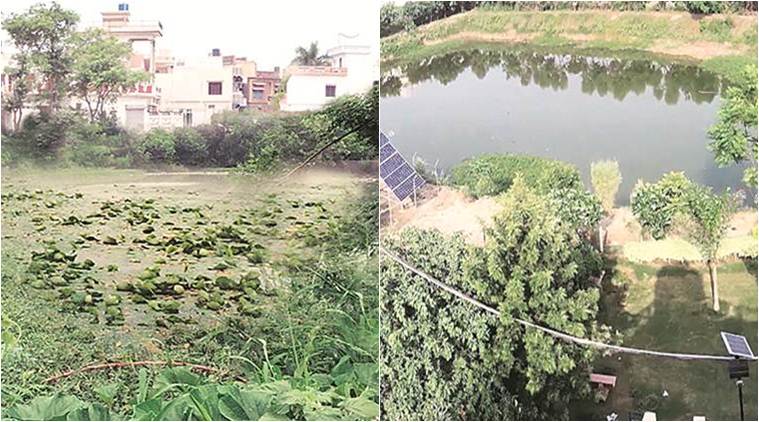A 2-km underground pipeline network now supplies water to his farm free of cost from the rejuvenated village pond.
Sandeep Singh, a former sarpanch of Manak Dheri village in Hoshiarpur district, too now irrigates his three acre farm with water from the village pond.
Farming had been a difficult proposition for Kans Ram. A resident of Nasirewal village in Sultanpur Lodhi sub-division of Kapurthala district, Ram is a marginal farmer owning 2.5-acre land. He doesn’t own a tube well – the boon and the bane of the farming community in Punjab.
Till last year, he had been dependent on the other farmers for water to irrigate his fields. The water, however, came at a cost and with a precondition that he won’t sow a crop that requires too much water.
“I was not able to sow the crop of my choice because water was not available to me. Those who used to provide me water used to put a condition that I’ll sow only that crop, which needs less water,” says Ram who used to pay Rs 3,000 to Rs 4000 for irrigating his fields every crop season.
A pilot project launched by the state soil conservation department, however, has changed all that. Ram can now grow any crop of his choice on his land and never worry about the availability of water.
A 2-km underground pipeline network now supplies water to his farm free of cost from the rejuvenated village pond.
Sandeep Singh, a former sarpanch of Manak Dheri village in Hoshiarpur district, too now irrigates his three acre farm with water from the village pond.
“The water is good and we don’t need to put too much fertilizer to improve the crop quality,” says Sandeep Singh. The underground pipeline network in his village stretches over 3.5km.
Saranjit and Sarwan Ram, both marginal farmers with around two acres of land at Nasirewal village, have a similar story to tell. So does Surinder Singh, a small farmer from Jalandhar’s Rurka Kalan village, who now doesn’t have to plead before other fellow farmers to let him use their tubewell.
These farmers are among hundreds across Punjab who are beneficiaries of the pilot project through which the soil conservation department has rejuvenated 54 village ponds in the over-exploited blocks of eight districts in state. These ponds now irrigate 1,139 hectares (2813 acres).
In Punjab, 83 per cent of total land is cultivable and there is huge demand of water, which if not checked, may turn the state into a desert in the next 25 years. With 80 per cent of the agricultural blocks in Punjab coming under overexploited category, the state has been looking at alternate sources of irrigation.
The pilot project is a step towards achieving that, especially for the small farmers and those who don’t have their own tube wells.
There are over 13,000 villages in the state with around 15,000 ponds and other water bodies.
The waste water from the village households flow into these ponds. With piped drinking water supply system making its way to the village households, the water flowing into these ponds has increased considerably over the years.
Often the village ponds overflow and the water enters nearby houses.
“Under the project, the ponds were renovated and rejuvenated to increase the water holding capacity and to ensure that water quality was fit for use in agriculture. Underground pipelines were laid from these ponds to take the water to agricultural fields.
Solar Photovoltaic (SPV) Pump sets were installed for pumping the water through the pipelines,” said Map Officer, office of chief conservator of soils, Punjab, Gurvinder Singh Dhillon.
The stagnant water in these ponds had often led to various health hazards in the villages besides numerous other environmental, economic and social impacts, he added.
“For instance an area with a population of 500,000 and a water consumption of 120 litres per day per person produces about 48,000 m3/day of waste water (assuming 80 per cent of the water used reaches the public sewerage system).
If this waste water were to be used in carefully controlled irrigation at a rate of 5000 m3 per hectare per year, it could irrigate some 3500 hectares”.
“If all the water bodies or ponds in the state are utilized in agriculture, it will not only help in checking ground water exploitation but will also provide farmer an assured irrigation water source besides avoiding drought incidences in agriculture as household water flows into ponds regularly irrespective of climatic variability’s,” he said.
“Besides it also helps in recharging of ground water. The projects are self sustainable with no operational costs,” said Naresh Gupta Gupta, Divisional Soil Conservation Officer, Hoshiarur.
Sub-divisional soil conservation officer, Jalandhar, Lupinder Kumar, said that in Ruruka Kalan, 2.4 lakh litres of pond water is lifted through solar pump and supplied in 2 km long area through underground pipeline system.
In Nasirewal and Rurka Kalan villages, the ponds are providing water to 60 farmers to irrigate over 100 acres of land.
The project was launched under under Pradhan Mantri Krishi Sichayee Yojana (PMKSY) in Jalandhar, Hoshiarpur, Ludhiana, Patiala, Kapurthala, SAS Nagar, Faridkot and Gurdaspur districts of Punjab. 1580 hectare area is to be brought under these 54 ponds.
Source: Read Full Article


